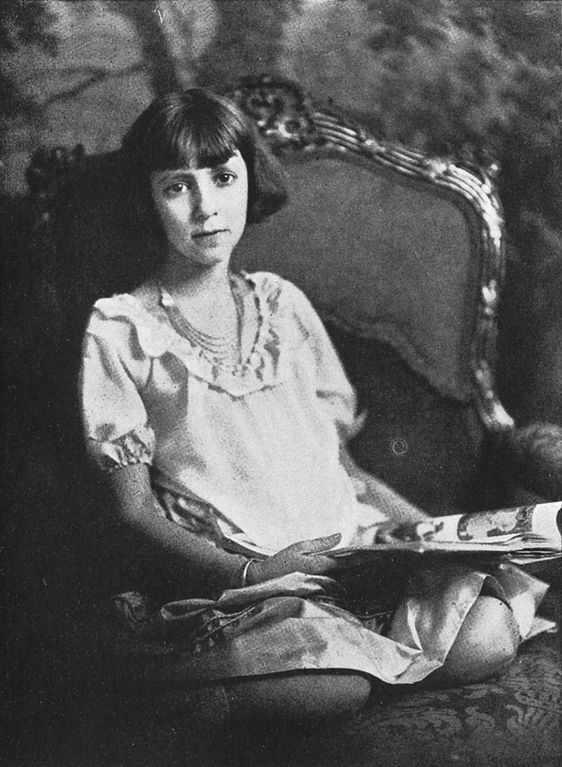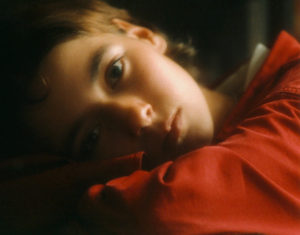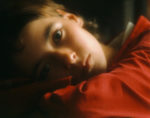
I will present here another girl poet who, like her contemporaries Hilda Conkling and Sabine Sicaud and the next generation’s Minou Drouet, started writing poetry at a very young age. But unlike Hilda Conkling and Minou Drouet, she did not give up poetry in her teenage years, and unlike Sabine Sicaud who died from a horrible disease at age 15, she lived for 85 years, writing poems and novels, also working as a professor of English at San Diego State University.
Nathalia Clara Ruth Crane was born on August 11, 1913, in Brooklyn, New York City, where she lived throughout her childhood. At age 9 she started writing poetry on a typewriter. Encouraged by her father, she sent some of her poems to journals, which published them. Her first collection of poetry, The Janitor’s Boy, and Other Poems, appeared in 1924 and made her famous as a “child prodigy.” The title follows that of the first poem, which, like the next six ones, celebrates her love for Roger Jones, the red-haired janitor’s son. After the publication of her second book, Lava Lane, and Other Poems in 1925, she was elected into the British Society of Authors, Playwrights, and Composers; she then was called “the twelve-year-old poet of Brooklyn” (see “Nathalia Crane Child Poet 1925”). She was dubbed “The Brooklyn Bard” when she published her third collection of poetry, The Singing Crow & Other Poems in 1926. But despite publishing poems until 1942, it seems that “the public lost interest in her poetry when they could no longer see the author as a child & teenager” (see The Weird Review). She died on October 22, 1998.
For the beginning of Nathalia’s poetic career, I quote the book Songs of Ourselves by Joan Shelley Rubin; on page 63, concerning girl poets, she writes:
One of the most famous of these was Nathalia Crane. A Brooklyn resident, Crane began composing verse on a typewriter in 1922, when she was nine. At the suggestion of her father, an erstwhile self-published poet and former newspaper copy editor, she sent two poems to an acquaintance of his, the managing editor of the Brooklyn Daily Times. The editor dispatched a reporter to interview the child. For the next few weeks, newspapers around the country ran articles treating Crane as a literary prodigy. A short time later, Crane sent another poem to the New York Sun, which accepted it without knowing the author’s age; subsequently William Rose Benét took two more for the New York Evening Post.
Some of the actors of her débuts left their testimonies in The Janitor’s Boy, and Other Poems. Nunnally Johnson, a reporter sent to interview Nathalia, wrote in “Nathalia at Ten” (the second foreword):
Nathalia had been writing her verse for several months before Mr. and Mrs. Crane came across it, writing it without fuss or excitement and storing it in a small and private album, content apparently with the reward of whatever pleasure the rereading of it gave her. If she had, even secretly, any concern with such a vanity as applause, she certainly did not betray it. And when shortly before Christmas of 1922, the little girl mailed some of her poems to a Brooklyn newspaper and received immediate acknowledgment from the editor, her parents were as much astonished as, later on, was the editor of a newspaper when, after having accepted a number of poems signed Nathalia Crane, the author herself walked into the office and proved to be a mite of a human being.
I was one of the file of reporters that trailed into Nathalia’s home the morning after her first publication, bent less on nourishing and encouraging a young artist than on getting a human-interest story. It was a file that eventually included generous, vociferous, and indiscriminate eulogists, a file that threatened to demoralize or spoil whatever young talents Nathalia had.
Those kind-hearted newspaper folks showered her with a shocking amount of almost unqualified praise, some of it accurately placed but most of it merely blank fire. This would have been very bad for her but for one thing—Nathalia never read any of it.
Of the New York Sun, which published poems by Nathalia without knowing her age, Edmund Leamy wrote in the Afterword:
In a maze of contributions such as the poetry editor of a large metropolitan newspaper printing daily two or three poems receives there came to me unheralded one morning in the mail a little poem which bore the name of an author of whom I had never heard—Nathalia Crane. It was a whimsical piece of verse such as an editor rarely receives, a rhythmical, lilting production that would gladden the heart of any one. It was called The History of Honey. Needless to say it was accepted for publication. Subsequently others submitted by Nathalia Crane also found a place in The Sun.
Then followed some correspondence in regard to various other poems but a call at the office made by the author in answer to a letter about the poem The Army Laundress disclosed to my amazement that the writer was none other than a little girl—a shy, unassuming youngster who was as embarrassed during the interview as I was myself. For I must admit I was embarrassed—or rather taken aback.
My surprise is excusable. So many times I had received “poems” from youngsters who were careful to give their ages in addition to their names; so often I had received visits from doting parents or relatives requesting publication of verses by their children or sisters or cousins that I had never dreamed any child would ever submit any work from his or her pen without adding the words “Aged — years.” But little Nathalia was the exception—and there was nothing in her poems that I received to indicate her age.
Finally, William Rose Benét of the New York Evening Post wrote in the Foreword:
When I took the two poems from Nathalia’s mother, and promised to read them, I had seen none of the press notices of Miss Crane’s talent. Being only a quasi-journalist I seldom read the newspapers. I am extremely skeptical of infant prodigies, and the poems of Nathalia’s that I have since seen most quoted in newspaper articles about her are just what you would expect. They prove nothing except that she is a little girl with a lively fancy. Certain poems in this first collection, however, seem to me to prove something more.
Now Songs of Ourselves continues:
Over the next five years Crane authored first more poems in periodicals and then two collections of verse. In 1925, eight hundred people attended her Christmastime reading in New York’s Aeolian Hall. At the same time, controversy erupted over whether Crane’s fans were the victims of a hoax. Edwin Markham, for one, declared that no child could have written the poems in her first book. The allegations prompted a flurry of interviews proving Crane’s authorship, along with a threat from the girl’s parents to sue their daughter’s detractors.
It seems that Nathalia was unaffected by the media hype around her case, as Nunnally Johnson hinted in “Nathalia at Ten” when he said that “Nathalia never read any of it.” He added:
And so, unaffected, she maintained the same tenor of her young days, playing with her dolls when she pleased and retiring to her boudoir to make rhythms when she pleased. She has always written, and still does write, only when the fancy prompts her.
Indeed, writing poetry meant for that girl an ordinary pastime, like playing, never a duty. Edmund Leamy concluded his Afterword as follows:
Nathalia Crane is a little girl who plays with dolls and toys and Roger Jones, whom she has glorified in some of her poems, when she is not busy at a typewriter giving expression to dreams and visions. She is also an author of delightful verse who obtained wide recognition of her work not because it was written by a child but because it was in itself worth while reading. For this alone, if for nothing else, she deserves all the success that is hers, all the laurels with which her friends and readers are glad to crown her and none more than the writer of this “Afterword” who came to know Nathalia Crane through her poetry which did not disclose her years.
Her writing rested much on spontaneous inspiration. According to the article “Nathalia Crane Child Poet 1925” in The Literary Digest of October 10, 1925:
She declared to those who came to congratulate her yesterday that her poems, the diction and thought of which have caused much comment, ‘just came.’ Ever since she can remember she has been writing little rimes, she said, and reading everything she could lay her hands upon. There are times when she feels something welling up within her for expression and she sits down at a small typewriter, her father explained, and croons out the words until they seem to fit her thoughts.
Generally her poems are made of stanzas containing each four short verses, with the second and fourth rhyming; one can thus consider each pair of lines as a long verse cut into two halves, similarly to an Alexandrine.
As I said above, the first seven poems of The Janitor’s Boy, and Other Poems (1924) sing her love for Roger Jones, the red-haired janitor’s son. That Roger is a good handyman, with an interest in shipbuilding, will appear clearly in several poems. I will present here the first three, then briefly summarise the next four ones. Here is the initial one:
THE JANITOR’S BOY
OH I’m in love with the janitor’s boy,
And the janitor’s boy loves me;
He’s going to hunt for a desert isle
In our geography.
A desert isle with spicy trees
Somewhere near Sheepshead Bay;
A right nice place, just fit for two
Where we can live alway.
Oh I’m in love with the janitor’s boy,
He’s busy as he can be;
And down in the cellar he’s making a raft
Out of an old settee.
He’ll carry me off, I know that he will,
For his hair is exceedingly red;
And the only thing that occurs to me
Is to dutifully shiver in bed.
The day that we sail, I shall leave this brief note,
For my parents I hate to annoy:
“I have flown away to an isle in the bay
With the janitor’s red-haired boy.”
This poem was put into a song by Natalie Merchant in her album Leave Your Sleep (2010). There is on YouTube a video of her singing it, with a photograph of Nathalia Crane behind her:
OH, ROGER JONES
OH, Roger Jones! Oh, Roger Jones!
Oh, Prince! O, Knight! Ah me!
We used to play at keeping house,
Beneath an old oak tree.
Your hair was red, your eyes were brown,
You had a freckled nose;
You were the father of my dolls,
My husband—I suppose.
Oh, Roger! You were only nine,
And I was half-past eight;
It really was romantic, or
As good, at any rate.
The third poem is in my opinion one of the most romantic and sensuous in the collection. Here the stanzas are made of two long verses, rhyming together:
THE FLATHOUSE ROOF
I LINGER on the flathouse roof, the moonlight is divine.
But my heart is all a-flutter like the washing on the line.
I long to be a heroine, I long to be serene,
But my feet, they dance in answer to a distant tambourine.
And, oh! the dreams of ecstasy. Oh! Babylon and Troy.
I’ve a hero in the basement, he’s the janitor’s red-haired boy.
There’s the music of his mallet and the jigging of his saw;
I wonder what he’s making on that lovely cellar floor?
He loves me, for he said it when we met upon the stair,
And that is why I’m on the roof to get a breath of air.
He said it! Oh! He said it! And the only thing I said
Was, “Roger Jones, I like you, for your hair is very red.”
We parted when intruders came a-tramping through the hall;
He’s got my pocket handkerchief and I have got his ball.
And so it is I’m on the roof. Oh! Babylon and Troy!
I’m very sure that I’m in love with someone else’s boy.
Alone, upon the starry heights, I’m dancing on a green,
To the jingling and the jangling of a distant tambourine.
To the stamping of a hammer and the jigging of a saw,
And the secret sort of feeling I’m in love forever more.
Do you think it’s any wonder, with the moonlight so divine.
That my heart is all a-flutter, like the washing on the line?
In the next two poems, “John Paul Jones” and “The Rovers,” her hero leads her in battle on a boat, first as a navy admiral, then as a rover captain. In both of them she calls him John Paul Jones instead of Roger, and she shows an extensive knowledge of seamanship terminology.
Then follows “The Vacant Lot,” telling how Roger wanted to build her on a lot a bungalow from all rubbish lying there, rusty cans, coffee pots and broken glass; but unfortunately builders came there, dug up the lot and started building a flathouse with brick and mortar.
In “The Swinging Stair,” Roger and Nathalia play at cruising on a boat by swinging a board; the end of the poem is rather ironic:
But never did we get beyond the gateway of our home.
We have notions that the motions of a lugger ‘neath a tree
Do not exactly tally with the leagues she makes at sea;
Yet the glory of the ocean lies in no far distant goal,
But reflections in the water, and the port to starboard roll.
Here “port” and “starboard” are the navy words for “left” and”right.”
In future posts, I will present further poems from the same collection, then from her futher ones, Lava Lane, and Other Poems (1925), The Singing Crow & Other Poems (1926) and Venus Invisible and Other Poems (1928).
Sources:
Nathalia Clara Ruth Crane, The Janitor’s boy, and Other Poems. Thomas Seltzer, New York (1924). Includes “Foreword” by William Rose Benét, “Nathalia at Ten” by Nunnally Johnson and “Afterword” by Edmund Leamy. Digital version on Internet Archive.
Joan Shelley Rubin, Songs of Ourselves, The Uses of Poetry in America. The Belknap Press of Harvard University Press, Cambridge, Massachusetts / London, England (2007).
“Nathalia Crane Child Poet 1925” in The Literary Digest, October 10, 1925.
Jessica Amanda Salmonson, “Girl Writers: Nathalia Crane, Vivienne Dayrell, & Daisy Ashford,” The Weird Review.
Previously published on Agapeta, 2017/08/27.

